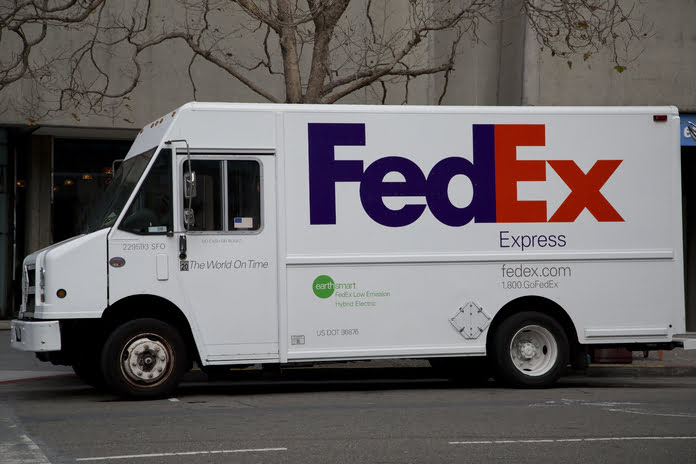Following the release of its FY2025 targets to the public at the investor day event on June 30, FedEx’s (NYSE:FDX) share experienced erratic trading over the past month.
The stock fell in the first half of July before rising in the second as investors tried to determine the overall effect of headwinds from a challenging macroeconomic environment and tailwinds from company-specific measures.
The company projects a 4 to 6 percent CAGR in sales over the next three years and an adjusted operating margin of at least 10% in FY2025.
The management also aims to boost cash returned to shareholders through dividends and share repurchases, significantly reduce capex, and improve ROIC.
Prior to that, FDX posted a strong quarterly result in a difficult environment, principally supported by double-digit yields across all segments.
While a challenging economic environment and challenges with the global supply chain are having an impact on company volumes, FedEx (NYSE:FDX) is focusing more on yields to generate revenue growth.
So What Does It All Mean?
Looking at FedEx’s present values, we can see that the stock is currently trading at a multiple of 10 times its FY23 EPS and 9 times its FY24 EPS.
This shows that investors are undoubtedly concerned about deteriorating macroeconomic conditions and lack faith in management’s growth objectives.
But it appears this company may still be able to gain given its low valuations … even if management can only partially fulfill its FY25 plans.
Key Metrics for FedEx
With the pandemic functioning as a stimulus for E-commerce demand, the company has seen solid revenue growth following the epidemic across all of its businesses.
The corporation was able to achieve good yield increases because the demand was surpassing supply and expanding. Additionally, the business adopted a number of pricing tactics, including E-commerce peak fees, which improved yields.
Revenues were significantly boosted by residential delivery services at FedEx Ground and an increase in US domestic package traffic at FedEx Express.
The volume trend for the ground section is beginning to normalize, though. The total average daily package volume for the ground segment decreased from 12.3 million in FY21 to 9.9 million in FY22.
Additionally, volumes for the express sector dropped from 6.7 million in 2021 to 6.2 million in 2022. These declines could be attributed to the challenging comparisons resulting from increased e-commerce demand in 2021 and a rise in the number of customers making in-person transactions.
Due to improved yields, the organization was nevertheless able to grow revenues despite volume challenges.
The Pandemic Effect
Shutdowns caused by COVID had a negative impact on operating profits and had a major impact on FDX’s operations in FY20.
As a result of increasing demand allowing the company to charge more in 2021 and pricing measures like E-commerce peak surcharges further aiding in yield growth, the company reported y/y operating margin expansion across the segments.
The company’s focus on improving the client mix helped it obtain higher yields. Because of pressure from the ground sector, the adjusted consolidated operating margin in FY22 was still lower than pre-pandemic levels.
As the company has begun to reap the rewards of TNT Express air integration, the express segment has been able to produce stronger operating margins than pre-pandemic margins.
What About FedEx’s Future Guidance?
At its most recent investor meeting, FedEx disclosed to the street its financial goals for FY25. Over the following three years, consolidated revenue is anticipated to increase at a CAGR of between 4 and 6 percent.
Adjusted EPS is projected to increase by 14 to 19 percent CAGR through FY25, translating to a range of $29 to $35 for FY25.
Management wants to achieve an adjusted consolidated operating margin of 10% by FY25 (vs. 7.3 percent in FY22).
By utilizing the integrated network, the ground segment is anticipated to produce adjusted operating margins of 11 to 12 percent by FY25.
With a strong LTL freight market, the freight segment is predicted to have an adjusted operating margin of 20%. With the advantages of TNT integration in Europe, adjusted operating margins for express are predicted to be between 8 and 9 percent by FY25.
Is all of this possible?
Future prospects for FedEx (NYSE:FDX) are divided along two paths, with challenging macroeconomic conditions acting as a headwind while company-specific initiatives like yield improvement, cost reduction, TNT integration, and lower capex aid the firm.
For one thing, online sales will increase ground revenue.
The pandemic was the main factor behind recent years’ increased growth in e-commerce. Although I think that over the next several years, the growth rate of e-commerce will revert to a more reasonable level, the long-term view is still very promising.
We still have a multi-year growth narrative with e-commerce as a percentage of retail in the U.S. at around 21%. The rise of small and medium-sized firms is projected to be significant.
By FY25, FedEx projects that the non-Amazon (NASDAQ:AMZN) domestic parcel market will increase from the current 57 million pieces per day to 67 million pieces per day.
Additionally, the business is developing new products like the FedEx Surround platform to assist its B2B clients in managing the supply chain more efficiently by averting any shipment problems.
FedEx Surround, for instance, enables its healthcare clients to recognize and prevent any problems that may arise with the package if it experiences stress.
The Bottom Line
Trading at a discount to its historical assessments, FedEx (NYSE:FDX) appears to be a smart investment. Over the next few years, the firm should expect to see strong earnings growth, which will be aided by attempts to improve yield, lower costs, integrate TNT, and increase utilization.
Featured Image: Megapixl @Wenling01

















